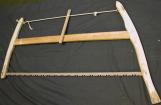1
In order to illustrate the simplicity, variety and simple beauty of some of the hand tools used in local boatbuilding, we relied upon the expertise of local boatbuilder, Nicol Warn. We showcase his personal collection of handtools, as well as artifacts from our museum's Workshop Collection. Aso featured is the handsaw that Hubert Evans used to make lumber from beach logs for his double ender, the infamous Georgia Strait Handtroller.According to Nicol Warn, many good boats have been built with little more than a sharp axe and a sheath-knife. Allen Farrell would have agreed and added chisels, a block plane and sandpaper.
Metal working tools are used for casting, forging and welding the metal parts found in most wood construction. Items made in the shop from iron could be drift bolts for fastening timbers like stern, keel and deadwood together, mast bands and specialty hardware for rigging, engine mounts, brackets and shafting, and custom fitted tanks.
2
MALLETS Example of handtools used in local boat building. See story 'Tools' for more info.1950
Personal Collection, Halfmoon Bay, British Columbia, Canada
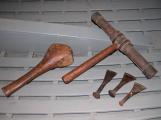
3
Carving Mallet (club shaped) 13 1/2" long-Used to drive the types of chisel that are designed to be hit with a persuader. Made from apple-wood crotch which is resistant to splitting because of its gnarled grain.
Caulking Mallet (t-shaped) 16" long with 1 11/16" diameter, with 13 1/4" long handle-
Used to drive caulking cotton or oakum into seams of carvel planked boats. The planks are laid edge to edge with an acute seam which is painted before caulking. Raw caulking cotton, which comes in bundles already formed into loose strands is usually looped and twisted as it is fed into the seam. Oakum, which is jute or hemp 'teased' from old rope and then soaked in organic tar, is added over the cotton in large seams. The three tools to the right of the caulking mallet are caulking irons; thin for cotton and thick for oakum.
4
FROE Example of handtools used in local boat building. See story 'Tools' for more info.1970
Personal Collection, Halfmoon Bay, British Columbia, Canada
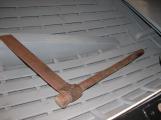
5
Froe -A froe is a riving tool for splitting wood along its grain. The blade is driven into the end-grain of a log or cant with a club made from yew wood. The yew wood handle of the froe is pulled sideways to exert a splitting force on the wood fibres. The blade can then be drawn or driven further into the split to work the split from one end to the other along its natural grain.
Planks for building clinker or lapstrake boats could be riven from the best straight grained red cedar with little waste. Steam bent frames were strongest if riven, as the grain was continuous and thus the frame did not crack as when short grained stock was used
6
HANDSAWS Example of handtools used in local boat building. See story 'Tools' for more info.1960
Personal Collection, Halfmoon Bay, British Columbia, Canada
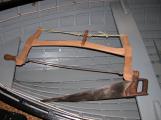
7
Rip Saw - 29" long, 3 1/2 teeth per inchThis coarse toothed handsaw is used for cutting with the grain and when properly sharpened and set can cut surprisingly fast. The teeth are sharpened like chisels, offset right and left so their path through the wood is wider than the body of the blade, thus reducing friction.
Bow Saw or Scroll Saw - 38 1/2" long, 17 1/4" wide and 16 1/2" blade
The blade is pinned into metal tangs fastened into the handles, which can be turned in their close-fitting tapered sockets so that the blade can be at any desired angle to the frame. Tension on the blade is provided by a spanish windlass. A poor man's bandsaw but it has the advantage over a bandsaw in that a cut can be started by assembling the saw with the blade inside a hole. Cuts can be made in situ which could not be done with a bandsaw. Blades of different widths and coarseness (teeth per inch) could be quickly changed for different jobs, eg. straight or scrolling cuts. The frame of this saw is made from dogwood and handles on either side of the blade are made of white oak.
8
PLANES, BRACES, BEVELS - Examples of hand tools used in local boat building.1940
Personal Collection, Halfmoon Bay, British Columbia, Canada
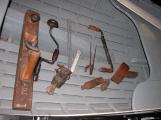
9
Shooting Plane: 22" long with 2 3/8" blade.The body of this plane is beech, carved to accommodate a blade, chip-breaker and frog combination (the metal parts) at the right angle to make long, straight cuts. The blade is sharpened straight across, so that the finished work is as "plane" and flat as possible. For much handtool construction, including furniture and cabinet work, this was the last tool to cut the surfaces that showed.
Brace - 15 1/2" long with 5" crank
This is a simple drilling brace for twist bits, with ball-bearing grips and a two-jaw chuck for holding tapered square shank bits.
Ink Line: 4 5/8" x 2 5/8" x 2 3/16"
Used to snap straight lines on log, timber or plank. Consists of a carved wooden body with a wooden crank operating a spool of linen line, which as it leads off the spool is held down into a charcoal and oil reservoir before exiting out a hole at the near end. The end of the line is secured to a sharpened jab-pin mounted in a wooden holder.
Adjustable Bevel: 8 5/8" short arm & 15 1/4" long arm. Just a larger than usual bevel for taking and transferring angles. Made from an old aluminum highway sign, stainless bolt, fender washers and a wingnut.
Dividers - 10" long. These lockable-angle dividers are used for scribing circles, spiling planks and otherwise transferring measurements.
Bucking Dolly and Setting Iron for clench nails and copper rivets - 8" long & 1 1/2" dia.
The dolly is used as a means of turning the flattened point of a boat nail (usually of galvanized iron) back into the steam-bent frame after it has been driven through both plank and frame. The narrower end is slightly dished to direct the tip of the nail. The tool can also be used to "buck" or back up the head of copper rivets when the other end of the rivet is being headed over with a ball-peen hammer.
The setting iron (6" long & 1 1/8" dia.) is drilled deep into one of its tapered ends, the other end having a slight depression to fit over the head of a rivet. The drilled end is used to back up the rove (a shallow conical washer that fits tight over the square shank of a rivet, usually on the frame side of a steamed-frame vessel) while the rivets are being driven home (set) from the outside of the hull. The rove grips the shank of the rivet, aiding in the final riveting performed with the ball-peen hammer. The dimpled end is used to buck the head while riveting.
Draw Knife - 16" long with 10 1/8" cutting edge.
This is used like a large spoke-shave, for carving oars, paddles and spars, chamfering rails, tapering stock, etc. Either deep or paring cuts can be taken, so it can be used for roughing-out or finishing. Cuts on the pull-stroke.
Wood-bodied Smoothing Plane - 9 3/8" long & 2" blade. Used for dressing surfaces that don't need to be dead-flat or finely finished. May be followed by the use of a jack-plane and shooting plane to achieve truly planar surfaces.
10
CHISELS, ADZE, AXE, SLICK - Examples of handtools used in local boat building.1930
Personal Collection, Halfmoon Bay, British Columbia, Canada
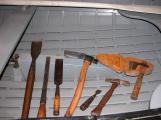
11
Slick: 28" long, 12 ¾" metal & 3" cutting edge.This is a type of chisel used for paring. The plane of the underside of the blade projects below the level of the handle, so that the handle doesn't impede the cutting action on a plane surface. It is not beaten with a mallet, but rather is used two-handed to smoothly slice shavings from (usually) broad surfaces such as the faying or mating surfaces of built-up timber structures (backbone members, frames etc.). The tool is heavy enough that its mass may also be used to jab, making it possible to remove quantities of wood quickly when roughing-out.
Mortising Chisel: 20 3/8" long, 15 ¼" metal & 1 1/8" cutting edge.
This is a socketed chisel with parallel sides and heavy, thick body, designed to cut mortices (slots) in timbers. It can be pounded when desired, and even pried on without shattering. The handle on this one is yew, with no banding, and has taken a considerable amount of pounding from wooden mallets with no sign of splitting. Like any other sharp chisel, it can be used for paring and precision cuts.
Framing Chisel: 15 7/8" long & 2" cutting edge.
Another socketed chisel, this one, manufactured by Greenlee, can be beaten on or can make fine paring cuts. The steel is both hard and tough, and weight is an advantage.
Gouging Adze: 9 ¼" long, 2 ¾" wide gouge & 18" handle.
For hollowing out, as in log canoe building. Two-handed use. 9 1/4 (236mm) head length; 2 3/4" (70mm) width of gouge.
Butt Chisel: 7" long & 1 1/8" cutting edge.
This short socketed chisel is used for close and detailed work. Generally one choses to use the largest chisel that will do the job, and this one is not large. Again, the handle is yew and has seen much "abuse" without breaking down. This is a favorite tool because of the fine steel.
Sculptor's Adze: 13 3/8" long, 6 5/8" head & 1 ½" cutting edge.
Of Italian manufacture, with a head of razor steel and handle of pear wood. It holds a fine, long-lasting edge. The gouge-shaped blade can be "dragged", cutting a long, controllable strip as it "snores" through the wood, either with the grain of the wood or across it. Uses: for coving planks, sculpting complex shapes in solid wood, adzing out depressions.
12
JAPANESE CARPENTER'S AXE - Examples of handtools used in local boat building.1980
Personal Collection, Halfmoon Bay, British Columbia, Canada
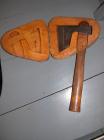
13
Japanese Carpenter's Axe: 13" long & 4 3/8" cutting edge.The head of this axe is thick right out to the cutting edge, which is beveled from both sides. The hand can be held right up behind the center of gravity and the center of effort due to the unique shape of the head, though that is not always the way it is used. The mass of the head being close to the cutting edge means that the blade is deflected less when chopping than would be the case with most western axes. Usually used one-handed for roughing out shapes like paddles and stems etc. Fine steel, handle of Japanese ash, scabbard of yellow cedar.
14
BUCKSAW - Example of handtools used in local boat building.1930
Sunshine Coast Museum & Archives, Gibsons, British Columbia, Canada
